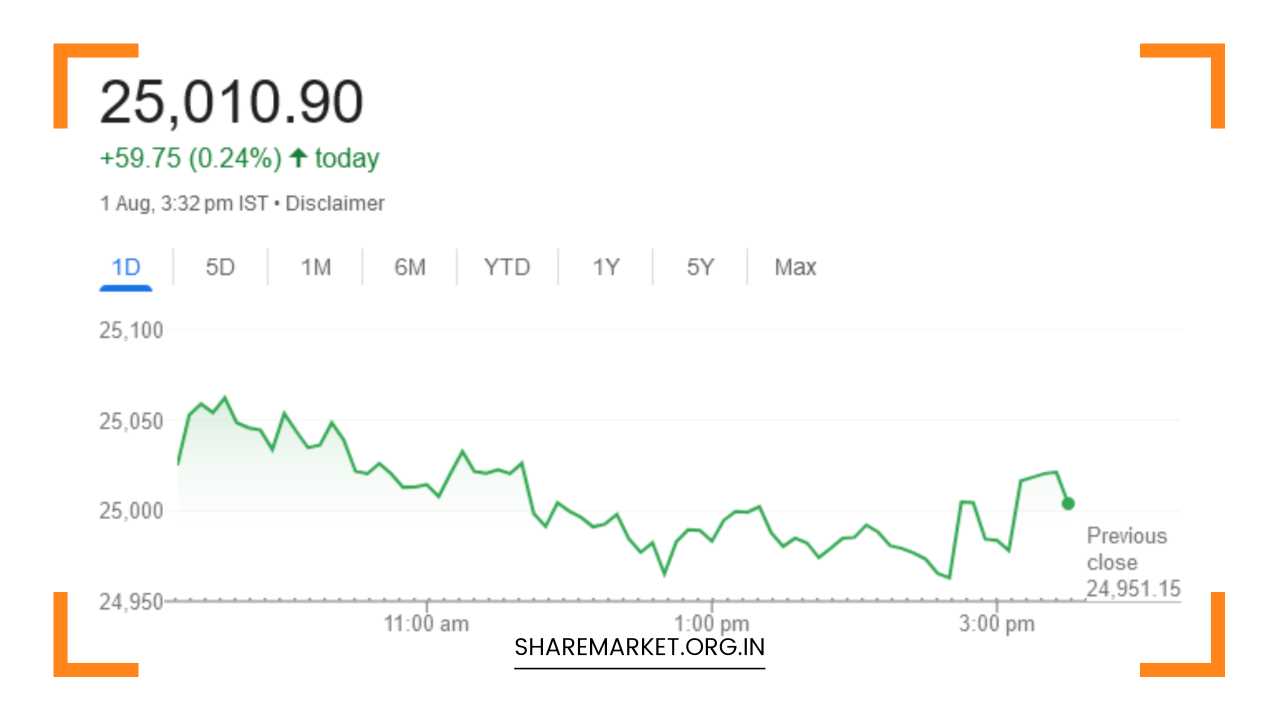Nifty Closed Above 25000; Nifty Prediction for Tomorrow

Nifty Prediction for Tomorrow
Nifty Breaches 25,000: A Bullish Start to August
The Indian stock market commenced August with significant momentum, with the benchmark indices reaching new milestones. The Nifty 50, India’s leading equity index, successfully surpassed the key psychological level of 25,000, closing the day at 25,010.90.
This represents a gain of 59.70 points, or 0.24%. Similarly, the Sensex mirrored this bullish sentiment, ending the day at 81,867.55, up by 126.21 points, or 0.15%.
This marks the fifth consecutive trading session of gains for both indices, reflecting a robust bullish momentum in the market.
However, the broader market exhibited a mixed performance. While the frontline indices performed well, the mid and small-cap indices underperformed, with the mid-cap index shedding 0.85% and the small-cap index declining by 0.98%. Despite this, the overall market tone remains optimistic, driven primarily by the performance of the leading indices.
Sectoral Trends
The sectoral performance displayed a distinct divergence. Key sectors such as metals, oil and gas, power, and energy showed resilience, attracting significant investor interest.
These sectors have been buoyed by favorable global and domestic factors, supporting their positive performance. In contrast, other sectors including automobiles, capital goods, information technology (IT), media, telecommunications, public sector banks (PSUs), and real estate faced selling pressure.
The auto sector, in particular, struggled due to weaker-than-expected monthly sales figures, which negatively impacted its constituent stocks. This sectoral divergence highlights the mixed nature of the market’s performance, with certain sectors thriving while others faced headwinds.
Market Prediction: A Cautious Optimism
Market experts have varied perspectives on the market’s trajectory for August 2. Their analyses provide valuable insights into potential future movements and areas of caution:
Aditya Gaggar, Progressive Shares: Gaggar notes that the formation of a spinning top candlestick pattern on the Nifty chart signifies indecision among market participants.
Immediate support for the Nifty is identified at 24,930, with resistance at 25,100. Gaggar advises a cautious approach due to these mixed signals, suggesting that while the market has shown strength, investors should be wary of potential volatility.
Vinod Nair, Geojit Financial Services: Nair highlights that the recent uptick in global markets, driven by the Federal Reserve Chair’s hints at potential interest rate cuts, has provided a positive boost to Indian equities.
However, escalating geopolitical tensions and disappointing auto sales data have tempered this enthusiasm. Nair anticipates that the market may experience a period of consolidation in the near term as these factors play out.
Jatin Gedia, Sharekhan: Gedia adopts a more bullish stance, citing the Nifty’s breakout from a period of sideways consolidation as a positive development.
He foresees the uptrend continuing, with potential targets at 25,330 and 25,530. Nonetheless, he acknowledges the possibility of short-term consolidation, given the divergence between daily and hourly indicators.
This suggests that while the medium-term outlook is positive, short-term fluctuations may occur.
Factors Influencing the Market
Several factors are poised to influence the market’s direction in the coming days:
Global Cues: Geopolitical tensions, particularly in the Middle East, remain a critical area of concern. Additionally, developments in the US economy and the Federal Reserve’s monetary policy stance will continue to influence global investor sentiment. These factors can lead to increased market volatility and affect investor behavior.
Domestic Factors: Key domestic elements include the progress of the monsoon season, government fiscal policy measures, and corporate earnings reports. These factors will play a significant role in shaping domestic market performance.
For instance, a favorable monsoon can positively impact agricultural productivity and related sectors, while government policies can influence economic growth and investor confidence.
Oil Prices: Fluctuations in crude oil prices are another important factor. Changes in oil prices can impact energy stocks and the overall market, given the significant role of oil in the global economy. Rising oil prices may lead to increased costs for businesses and consumers, while falling prices can have a beneficial effect.
FII and DII Activity: The investment flows from Foreign Institutional Investors (FIIs) and Domestic Institutional Investors (DIIs) are crucial in determining market trends. The buying or selling activities of these large investors can significantly influence market movements, either reinforcing or counteracting prevailing trends.
Investor Perspective
For investors, maintaining a balanced approach is crucial amid the current market dynamics. While the upward trajectory of the market is encouraging, it is essential to remain cautious and avoid making impulsive decisions.
A long-term investment horizon, coupled with a diversified portfolio, can help mitigate risks associated with market volatility.
Investors should consider conducting thorough research or consulting with a financial advisor before making investment decisions.
This approach ensures that investment choices align with individual financial goals and risk tolerance, thereby enhancing the likelihood of achieving favorable outcomes.
In conclusion, the Indian stock market’s strong start to August, characterized by the Nifty 50 breaching the 25,000 mark, signals positive momentum. However, the mixed performance across sectors and varying expert opinions underscore the importance of cautious optimism.
Investors are advised to stay informed about global and domestic factors, sectoral trends, and market indicators to navigate the evolving market landscape effectively.
Disclaimer: This article is intended for informational purposes only and does not constitute financial advice. It is recommended to consult with a financial advisor for personalized investment guidance.

















